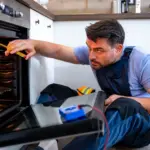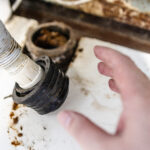If your refrigerator is not properly defrosting, it can lead to excess frost and ice, reducing cooling efficiency and potentially damaging your appliance, so timely refrigerator repair is very important. The problem often lies within the automatic defrost system, which relies on several key components to function correctly. Understanding the common causes of defrost failures and how to troubleshoot them can help you restore your refrigerator’s performance and keep your food safely stored.
Frost Warning: The Main Causes Your Refrigerator Won’t Defrost
If the evaporator coils show signs of significant frost or ice build-up, the automatic defrost system is probably malfunctioning. Here are the five more likely reasons why it is not defrosting:
Burned Out Defrost Heater
The defrost heater won’t do much defrosting if it can’t “heat up.” Often, you can determine whether a heater has burned out by looking for any blistering or a visible break in the component. The heater can also be tested for “continuity,” or a continuous electrical path, using a multimeter. The heater is unquestionably faulty if the continuity test results are negative.
Malfunctioning Defrost Thermostat
A broken thermostat can stop the heater from turning on because it controls when the heater receives voltage. The thermostat can be tested for electrical continuity using a multimeter, just like the heater, but a reading of 15°F or less is required.
Faulty Defrost Timer
Models with a defrost timer may experience issues with the timer sending voltage to the heater during the cycle or failing to advance into the defrost cycle. Make an effort to gradually move the timer dial into the defrost cycle. The heater should activate, and the compressor should stop. The timer should be replaced with a new part if it fails to advance out of the defrost cycle within 30 minutes or if it prevents voltage from reaching the heater.
Defective Defrost Control Board
The defrost control board in your refrigerator may be broken if it regulates the defrost cycle using a board rather than a timer. Although testing the control board is difficult, you can check it for indications of burning or a shorted-out component.
Main Control Board Failure
The main control board of the refrigerator controls the power supply to all of its parts, so if it fails, it might not be able to send voltage to the defrost system. You should rule out other potential causes before replacing the main control board.
Chill No More: How to Rescue Your Fridge from Defrost Disaster
If your refrigerator is not defrosting, it is most likely due to a failure in one of the components of its defrost system. You can often diagnose and fix these issues yourself by following a few refrigerator repair steps.
| Protip! Before you begin any inspection, unplug the refrigerator to prevent electrical shock. |
Continue reading to find out how to fix a refrigerator that isn’t defrosting:
Manually Defrost The Freezer
Unplug the refrigerator and leave the doors open to manually defrost the freezer as a temporary solution. After absorbing the ice with towels, let it defrost completely for 24 to 48 hours before re-plugging it.
Clear A Clogged Defrost Drain Line
Ice buildup may result from melted water refreezing due to a clogged defrost drain line. Find the freezer’s drain hole and use a pipe cleaner and a solution of baking soda and hot water to clean it.
Clear A Clogged Defrost Drain Line
A malfunctioning defrost timer in certain refrigerators keeps the system from going into the defrost cycle. To see if the heater turns on, you can manually advance the timer. The timer probably needs to be changed if it doesn’t.
Check The Defrost Heater
Unplug the refrigerator and leave the doors open to manually defrost the freezer as a temporary solution. After absorbing the ice with towels, let it defrost completely for 24 to 48 hours before re-plugging it.
Test The Defrost Thermostat
A switch known as the defrost thermostat keeps the heater from activating when the coils get too warm. The heater will not turn on if it fails. When the thermostat is cold, check for continuity using a multimeter.
Conclusion
A little troubleshooting and component testing can frequently resolve the common problem of a refrigerator that won’t defrost. You can restore your appliance’s defrost function and stop additional issues by being aware of the probable causes and adhering to detailed refrigerator repair instructions. For safe and efficient repairs, it is always best to seek the advice of a qualified technician if you are unable to locate or resolve the problem.
FAQs
Why is there frost in my fridge?
Excess frost usually indicates a defrost system malfunction.
How often should a refrigerator defrost?
Most auto-defrost units defrost every 8-12 hours.
What happens if I ignore defrost issues?
Frost buildup can reduce cooling efficiency and may damage the appliance.



